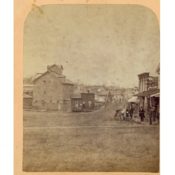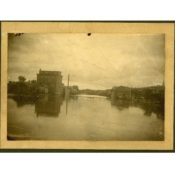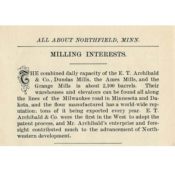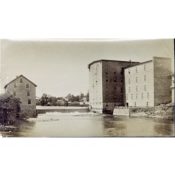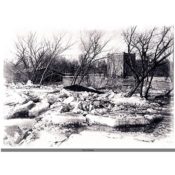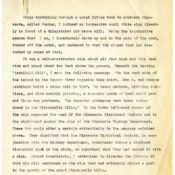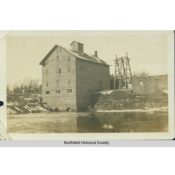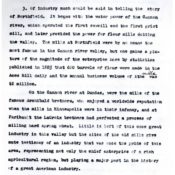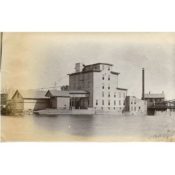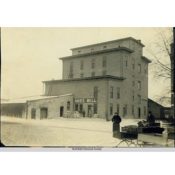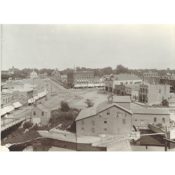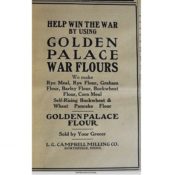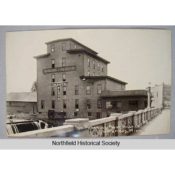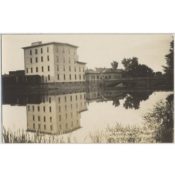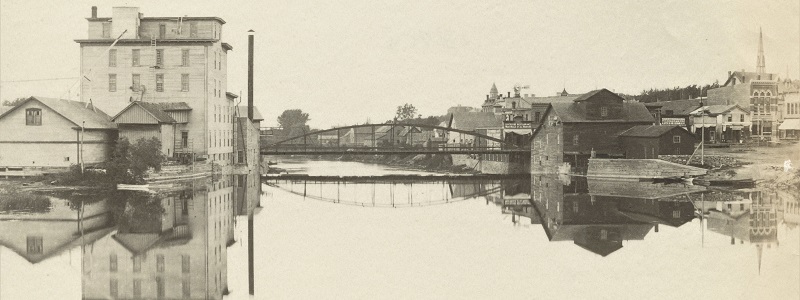
By Stephanie Hess, Northfield-Rice County Digital History Collection, January 2019
Northfield exists because of milling. When town founder John W. North came to this area in 1855, he saw right away that the Cannon River could be used to power mills. “I did not at first contemplate starting a town,” he wrote in 1880, “much less a city. I only thought of a mill.”
By the winter of 1855, North started building a dam on the river and a sawmill on its west bank. Then he built a flour mill on the east side, across the dam from the sawmill. Water from the river turned a waterwheel which ground wheat between millstones and turned it into flour. During this time, North also planned out a town along the banks of the river and called it Northfield.
After he lost money during the Panic of 1857, John North sold his mills to his friend Charles Wheaton. Wheaton ran both mills until he sold them to Jesse Ames in 1865. Jesse Ames & Sons rebuilt North’s original sawmill as a larger, improved flour mill in 1869.
This new mill made better flour in less time than the old mill. Its flour was declared the best straight flour in the nation at the Centennial Exposition in Philadelphia in 1876. From that point on, this mill was called the Ames Mill.
The Ames Mill could make high-quality flour because it used a new technology to separate the tough outer bran coating from the inner wheat kernel. This system was called a “middlings purifier.” Nicholas and Edmund LaCroix developed the middlings purifier while working with Alexander Faribault in the 1860s. The Ames Mill was one of the first mills in Minnesota to use a middlings purifier.
The Ames Mill was not the only mill in the area. In fact, at the height of the milling industry in the 1860s and 1870s, there were 22 mills along the Cannon River between Morristown and Northfield. Faribault saw the earliest sawmill in 1854 and flour mill in 1856. The Archibald brothers built the Northfield area’s first stone mill in Dundas in 1857. Other small towns used the Cannon’s water power for flour, grist, woolen, and sawmills.
The milling industry in the Northfield area began to decline in the 1880s for several reasons. Local farms struggled to grow quality wheat due to a blight disease that ruined their harvests. Others began to grow other crops to make more money, so there was less wheat available to grind into flour. The larger mills in Minneapolis competed with these smaller mills for resources and often put them out of business.
The Ames Mill saw a decline in production for all of these reasons, especially after Jesse Ames & Sons sold it. Several owners ran it for only a few years at a time. The L. G. Campbell Milling Co. made a variety of milled products in the Ames Mill during the World War I era. Then the Theobald Flour Mills Company ran the mill from 1918 to 1922. It was home to the Northfield Flour Mills Co. after that.
In 1927, John S. Campbell acquired the Ames Mill for the Campbell Cereal Company. He improved the building and changed it from a flour mill to a cereal manufacturing plant. Ever since then, the Ames Mill has been the production center for his signature product: Malt-O-Meal hot cereal.
The milling industry is important to the area because it helped turn Northfield into a town center. The mills supported local farmers and merchants. Milling was a major employer of Northfield townspeople. It provided income to its owners who invested in the community in many ways. It was the business that started Northfield.
Primary Sources
Discussion Questions
When you look at the individual items in the Northfield-Rice County Digital History Collection, use the zoom-in tool to view details in the images or more easily read the documents. Use the tab labeled “TEXT” to read full transcriptions of the documents.
Questions
- What kind of resources – natural and otherwise – are needed for milling? Did Rice County have them? Does it still have them?
- Why did John North build a sawmill before he built a flour mill?
- How has the Ames Mill affected the settlement, growth, and development of Northfield?
- Milling is an industry, which means it is a kind of business that provides a product or service. In this case, milling provides the service of grinding grains of wheat into flour, which can be used to make many products. What other industries have been important in the Northfield area? In Minnesota? In the country? How have these industries changed over time?
- Compare and contrast how people viewed Northfield’s water resources in the past vs. today. What was its value in the past, compared to today? Have we changed how we use water and waterfront properties? How? Why?
- How has the technology of milling changed over time? Especially in the sources of power: water, steam, electricity.
- How did changes in the machinery of the mills affect the employees both in terms of their number and their duties?
- The Northfield area also is known for its agriculture. What is the relationship between agriculture and milling?
- What made milling such a successful and important industry in Northfield and the state as a whole?
- Minneapolis was known as the Milling Capital of the World in the 1880s, yet the mills in the Northfield area pioneered the same technologies that Minneapolis mills used. What factors have made the Minneapolis mills more famous?
Related Items on the Northfield-Rice County Digital History Collection
Ames Mill photographs and documents
The Ames Mill, by Erin Frankson
Early Northfield History scrapbook, especially page 68 and page 72.
Growth of Northfield in Seventy-Five Years, by Frances Bishop
Classroom Activities and Additional Resources
Activities and Lesson Plans
Forests, Fields, and the Falls: Connecting Minnesota. Minnesota Historical Society, 2016. Web (accessed October 9, 2018).
Wheat Farms, Flour Mills, and Railroads: A Web of Interdependence. Teaching with Historic Places Lesson Plan by the National Park Service, U.S. Department of the Interior. Web (accessed October 9, 2018).
Additional Resources for Research
Bretheim, Laura. “Historical Perspectives on the Ames Mill: Northfield, MN.” In Exit 69: Environmental Histories of Northfield, Minnesota website. Northfield: St. Olaf College, May 18, 2013. Web (accessed May 24, 2018).
Clark, Clifford, ed. Minnesota in a Century of Change: the State and its People since 1900. St. Paul: Minnesota Historical Society Press, 1989.
Danbom, David B. “Flour Power: The Significance of Flour Milling at the Falls.” In Minnesota History Magazine, Vol. 45, No. 5-6 (2003): 270-285. Available online (accessed October 9, 2018).
Fossum, Paul R. “Early Milling in the Cannon River Valley.” In Minnesota History: A Quarterly Magazine 11, no. 3 (1930): 271-292. Available online (accessed May 24, 2018).
Johnson, Frederick. “King Wheat in Southeastern Minnesota.” MNopedia, Minnesota Historical Society. Web (accessed June 13, 2018).
Minneapolis Flour Milling Boom. Mill City Museum of the Minnesota Historical Society. Web (accessed October 9, 2018).
National Register of Historic Places Inventory – Nomination Form for the Archibald Mill in Dundas. Completed 1976. State Historic Preservation Office, Minnesota Historical Society. Available online (accessed June 13, 2018).
Northfield Bicentennial Committee. Continuum: threads in the community fabric of Northfield, Minnesota. Northfield, MN: The City of Northfield, 1976.
Northfield Heritage Preservation Commission. Northfield: The History and Architecture of a Community. Northfield, MN: Northfield Printing, 1999.
Our Story: A Guide to the History of Northfield Minnesota. Northfield: Northfield Historical Society Press, 2013.
Primary Source Analysis
Here are some tips for analyzing the primary sources found above and throughout the DHC. For each source, ask students to indicate:
- the author’s point of view
- the author’s purpose
- historical context
- audience
For inquiry-based learning, ask students to:
- explain how a source tells its story and/or makes its argument
- explain the relationships between sources
- compare and contrast sources in terms of point of view and method
- support conclusions and interpretations with evidence
- identify questions for further investigation
Additional Tools
- Document Analysis Worksheets from the National Archives
- Teaching with Primary Sources Videos and Sets from the Minnesota Historical Society
- Using Primary Sources from the Library of Congress
Minnesota Education Standards
Here is a list of education standard codes for benchmarks that can be explored using this Primary Source Set.
- 0.4.1.2.1
- 1.4.1.2.1, 1.4.2.4.1, 1.4.2.4.2
- 2.4.1.1.1, 2.4.1.2.1
- 3.4.1.2.1
- 5.4.1.2.1
- 6.3.3.6.1, 6.3.4.10.1, 6.4.1.2.1, 6.4.4.18.1, 6.4.4.20.1
- 7.4.1.2.1, 7.4.4.18.2, 7.4.4.20.1
- 9.4.1.2.1, 9.4.4.18.1, 9.4.4.20.3
- 1.8.7.7
- 2.8.7.7
- 3.2.7.7, 3.6.2.2, 3.6.7.7, 3.6.8.8, 3.8.2.2, 3.8.7.7, 3.8.8.8
- 4.2.7.7, 4.6.2.2, 4.6.7.7, 4.6.8.8, 4.8.2.2, 4.8.7.7, 4.8.8.8
- 5.2.7.7, 5.6.2.2, 5.6.7.7, 5.6.8.8, 5.8.2.2, 5.8.7.7, 5.8.8.8
- 6.12.1.1, 6.12.2.2, 6.12.4.4, 6.12.7.7, 6.12.9.9, 6.14.2.2, 6.14.7.7, 6.14.8.8
- 9.12.1.1, 9.12.2.2, 9.12.4.4, 9.12.7.7, 9.12.9.9, 9.14.2.2, 9.14.7.7, 9.14.8.8
- 11.12.1.1, 11.12.2.2, 11.12.4.4, 11.12.7.7, 11.12.9.9, 11.14.2.2, 11.14.7.7, 11.14.8.8
Send us feedback about this primary source set.
This publication was made possible in part by the people of Minnesota through a grant funded by an appropriation to the Minnesota Historical Society from the Minnesota Arts and Cultural Heritage Fund. Any views, findings, opinions, conclusions or recommendations expressed in this publication are those of the authors and do not necessarily represent those of the State of Minnesota, the Minnesota Historical Society, or the Minnesota Historic Resources Advisory Committee.

